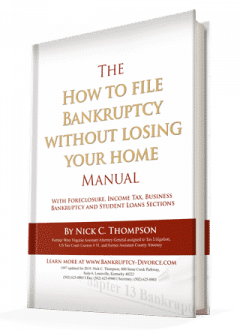If you are filing bankruptcy you must give an accurate listing of all income, assets, debts, and expenses in a bankruptcy voluntary petition. Furthermore, the more you educate yourself and plan your bankruptcy, the better your outcomes.
Including Assets, Debts, Expenses, and Income in a Bankruptcy Petition
Sometimes a person does not want to list all their assets because they want to keep the asset. Let me give you a few examples:
- Let’s say I want to keep a ring because it belonged to my mother. I may be tempted to “forget” to list it on the petition. However, it would be far better to list the ring as an asset and protect it with one of my exemptions. The bankruptcy code in many states offers a large exemption so that it is rare that anyone loses any property if they list and exempt it.
- For example, let’s say I have a boat that’s free and clear of any debt. I may be tempted to transfer the title of the boat to my son a few months before I file bankruptcy in order to “protect it”. This is called a fraudulent transfer if I am not paid in return for the fair market value of the boat. I may be able to protect the asset with one of my exemptions if it is in my name. However, after I transfer it I don’t own it and I lose the ability to protect it.
- Finally, let’s say I have a 401K valued at $150,000. This asset is fully protected and the trustee would not be able to seize the funds in order to repay the debt(s).
The important thing to remember is to discuss your assets with your bankruptcy attorney in order to determine how to best use your exemptions and to prevent a fraudulent petition.
⎆ All debts must be listed in a bankruptcy petition.
Likewise, you must list all your debts. Sometimes a person doesn’t want to list all their debts because they want to continue to pay. Another reason might be because of fear that the creditor won’t allow them to keep their car or another item.
1. Example scenarios of listing debts.
Let’s say I want to keep my car. If I list the debt and keep paying the payments, my car will generally not be repossessed by the lender. However, if I fail to list the car note, it then appears that I own the car free and clear, so then, the Trustee may be able to take it. Conversely, listing the debt makes the petition clear and accurate which is the primary goal.
- Second, let’s say I like my doctor and I want to continue seeing her. I can list the debt in the bankruptcy and still make payments to her and continue to use her as my doctor.
2. Other reasons to list all your debt.
- When you file, notices are mailed to each creditor and once they receive notice, they cannot continue to try and collect on your debt.
- It is expensive to reopen a case and add a debt you forgot.
If you don’t include all your debts, then you may not discharge those debts. In our district, a case called IN RE Madj says in no-asset cases debts are discharged whether they are listed or not. This means if pay back debts in Chapter 13 or 7, then you must be very thorough in listing your debts, or you will end up paying them later. You might even appear to be filing a fraudulent petition or lose the property if you fail to list a debt or lien.
Be certain to include all your debt, especially any child support or alimony payments, which allows you to deduct for that expense. If you write a check for it or it is payroll deducted, it must be in your budget as debt or expense. Some debts are easy to forget, such as your annual property taxes. That doesn’t mean they are not necessary. Leaving them out makes your budget unaffordable. Replacing furniture, cars, and property maintenance such as a roof or furnace must be in the budget.
⎆ List expenses in detail for a successful bankruptcy.
The expenses you may deduct include secured, normal, and necessary expenses. Chapter 13 will fail if you don’t include reasonable and necessary expenses. Expenses include your property taxes, school lunches, insurance, and health costs. It may also include your monthly church tithes, 401k, or 401k loan repayment.
It can include private school tuition if the child has a disability and the school is necessary for the disability. However, if the expenses include large private school tuition, church tithe, and 401k, you must document a history of these expenses. For instance, you can’t put your child in school the week before filing and expect to take the expenses to get out of filing Chapter 13.
Expenses for children are more understood and tolerated than expenses for luxury items like a motorcycle payment. Expenses are allowable for church tithe and reasonable 401k when there is a history of prior contribution.
An attorney who fails to include necessary expenses will place a client into a Chapter 13 plan that is not repayable. Additionally, your budget averages fluctuating utility bills. Unusual expenses like an $800 monthly medical prescription need documentation and proof that it is a necessary expense.
⎆ Include all income in a bankruptcy petition.
For purposes of the means test, you must include all monthly income in your bankruptcy petition. This includes the following items. But please be aware that this list is not exhaustive. So, continue to do your research and work closely with an attorney with the right experience.
- Annuity payments.
- Interest, dividends, and royalties.
- Net income from rents and other real property income.
- Net income from the operation of a business, profession, or farm (the amount you report as taxable income, after subtracting reasonable and necessary business expenses on IRS Schedule C.)
- Pension and retirement income.
- Regular contributions by the debtor’s spouse (unless you are legally separated).
- Regular contributions to the household expenses of the debtor or the debtor’s dependents, including child or spousal support.
- State disability insurance.
- Unemployment compensation.
- Wages, salary, tips, bonuses, overtime, and commissions.
- Workers’ compensation insurance.
For both Chapter 7 and Chapter 13 bankruptcy, including your spouse’s income is also a requirement. For Chapter 7, the means test requires you to list your spouse’s income in addition to yours. In Chapter 13, in order to calculate plan payments, include your spouse’s income on Form 22C to determine your disposable income.
⎆ In summary
To summarize, the bankruptcy trustee must have an accurate picture of your financial situation. This means all the income, expenses, assets, and debts must be listed. Be sure to discuss this with your attorney in order to prepare an accurate petition and protect as many assets as possible.
 Resources for Bankruptcy
Resources for Bankruptcy
Louisville Kentucky Bankruptcy Forms
Other Related Information
How to Qualify for Chapter 7 • Video
How to Keep Your Property When Filing Bankruptcy in Kentucky
Chapter 7 or 13 Bankruptcy Trustees and the 341 Hearing
Chapter 13 Bankruptcy in Louisville Kentucky
Retirement Benefits & 401k in Bankruptcy
If you are thinking about filing bankruptcy, don’t delay because timing is crucial. I am here to help you. So, contact my office right away to start the conversation. Nick C. Thompson, Bankruptcy Lawyer: 502-625-0905







